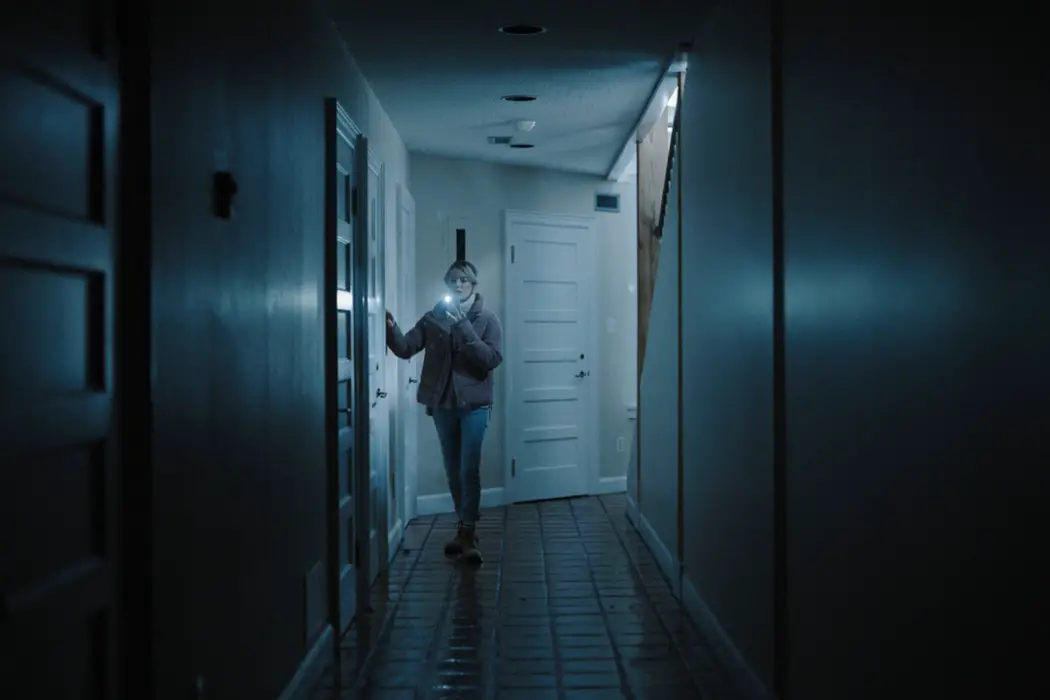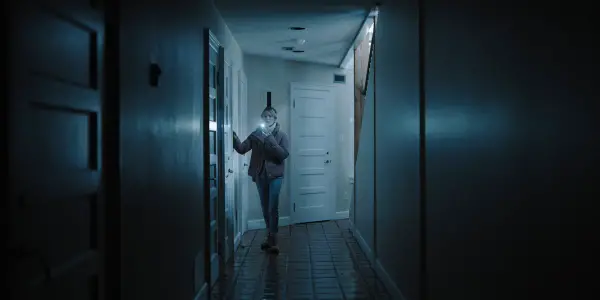TRIBECA FILM FESTIVAL 2021: SEE FOR ME

Stephanie Archer is 39 year old film fanatic living in…
There has been a quietly building trend within the horror genre over the last few years, one that pries on the absence of sense – primarily sight and sound. From Hush to Birdbox to A Quiet Place, the isolating and heightened challenges within danger have entertained and terrified. While some may boast of their success through sequels and box office revenues, others have floundered under their depictions, unable to deliver the horror originally promised.
See for Me, from director Randall Okita, is the latest film to tackle this trend, presenting audiences with Sophie (Skyler Davenport), a former alpine skier whose loss of sight has affected her both emotionally and mentally. Yet, while her fight against home invaders may seem appealing, the film’s disjointed nature of narrative and horror leaves much to be desired.
Beauty Does Not Always Equal Greatness
See for Me begins on the slopes, an extreme close-up on Sophie’s eyes just before lowing her goggles, setting a character trait early on. Sophie is someone who always has her eye on the prize. This is where the film is at its best, in the tranquility of crafting the shot. You can almost hear the crew behind the camera holding their breaths as the shot is captured and taken in. See for Me is littered with many of these breathtaking moments, the diamonds in the rough.
Viewers are quickly taken from the slopes and brought to Sophie’s present as she feels through her closet, clothes pins indicating type and color. She has adjusted to her blindness in surroundings and utility only, her inability to listen to sportscasters relay a skiing event on the TV speaking to how much farther she has to go in her recovery and her acceptance. As she tip-toes her way to the door, she is stopped by her mother, whose concern should heighten the concept of her emotional and mental status, but unfortunately just reads as an overbearing mother. Unlike her, we have not been included in the loss of Sophie’s sight. We did not watch the struggles and the recovery. Furthermore, this lack of empathy for the mother transfers to Sophie as there is no immediate connection with her from an audience perspective.

As Sophie leaves for the home she is house-sitting for, viewers are taken on the scenic drive, seeing the world for her, both inside and outside of the cab. Yet, as gorgeous the shots may be, the introduction drags on too long, feeling more like filler. It is at this point, the film threatens to begin losing its viewers.
Disjointed Mess
After arriving at the house, it feels as though the film is begging to find its legs, Sophie presenting a challenge to the conscious and empathetic nature of audiences as we learn more about her and her newly minted means of income. As she walks the house (which is vaguely reminiscent of When a Stranger Calls), there is a foreboding sense within each element. While it heightens some of the presumed intensity of the film, it also teeters on the line of predictability.
As Sophie gets locked outside the house, she is forced to use a new application her mother recommended called “See For Me”. Connecting in with Kelly (Jessica Parker Kennedy), Sophie is able to navigate herself back into the house, deactivating the alarm and formulating a connection with someone beyond the house. While breaking the confines of the secluded forest home, it disjoints the film in concept and structure. This connection between the girls feels forced, further lending itself to filler throughout the film (in one Die Hardesque scene in particular).
What the introduction further challenges are the film’s ability to transition evenly. With the introduction of Kelly and the See For Me app, the film loses its flow. Yet, this flow is further disrupted with the introduction of the home invaders, who Kelly must aid Sophie in evading. As the film continues, constantly adding storylines and characters, there is a sense of multiple ideas being glued together. The rigidity of the narrative and multiple concepts lends itself to an inability of the filmmakers to be flexible in their storytelling as each newly introduced idea is far from seamless or blended. It is as though there was an idea, and that’s what they went with, no matter the outcome.
Yet, this rigidity is not limited to the filmmakers, but to its cast as well. There is deep recognition for the casting of Skylar Davenport, her visual impairment leaning into the further inclusion of disabled casting. Unfortunately, their performance reads off as to rigid, unable to garner the empathy from the audience needed to build investment in their character’s story. Kennedy, delivers more of a commitment to her role, but she too lacks the authenticity in her performance to heighten the intensity and emotional turmoil of the situation her character has found herself in.
Conclusion: See For Me
There is a gem of a story here within the film’s more psychological layers, yet See for Me never truly commits nor leans heavily into them. Its inability to be flexible also works to its detriment, the film’s stubbornness to be what it’s going to be mirroring that of its central character. Referencing and reminiscent of horror films that have come before, See for Me does not live up to its inspirations.
See For Me is currently available on-demand on Tribeca at Home until June 23rd
Does content like this matter to you?
Become a Member and support film journalism. Unlock access to all of Film Inquiry`s great articles. Join a community of like-minded readers who are passionate about cinema - get access to our private members Network, give back to independent filmmakers, and more.













